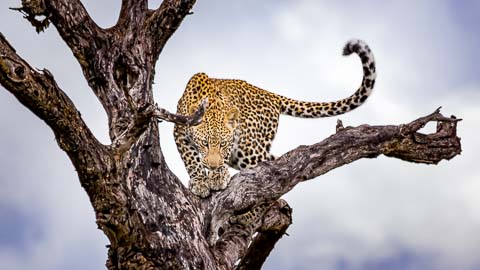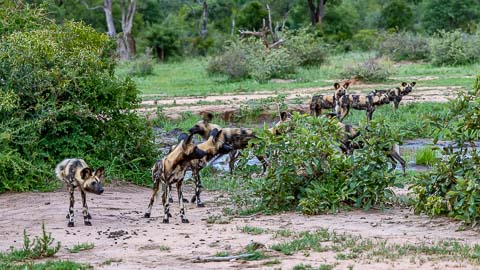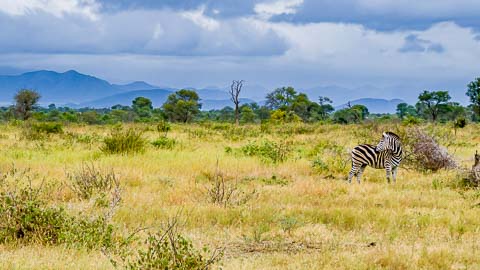Lying in the heart of the Lowveld is a wildlife sanctuary like no other, its atmosphere so unique that it allows those who enter its vastness to immerse themselves in the unpredictability and endless wilderness that is the true quality of Africa.
The largest game reserve in South Africa, the Kruger National Park is larger than Israel. Nearly 2 million hectares of land that stretch for 352 kilometres (20 000 square kilometres) from north to south along the Mozambique border is given over to an almost indescribable wildlife experience. Certainly it ranks with the best in Africa and is the flagship of the country’s national parks.


Boasting an exceptional diversity of game, it is home to more different species of wildlife than any other natural sanctuary in Africa. Visitors can set out in search of the Big Five in their own cars or on guided game drives.

Thanks to its large size the Kruger covers a variety of different landscapes, from the grassy plains of the south to the thick mopane thickets and baobab trees of the north. The park is home to a large population of elephant, as well as large herds of buffalo. Predators include lion, cheetah and hyena, as well as the elusive leopard, which are mainly nocturnal, and African wild dog, which are occasionally spotted in the park.


Distance - 10,7 km (6.6 miles)
Wonderous wildlife, thrills and spills, ancient history, warm hospitality, exploring cultures and making memories. Few parts of the world can match the Kruger Lowveld for its natural and cultural diversity. It's in our nature!

Gods Window - Blyde River Canyon
As South Africa’s premier inland tourism and leisure destination, the Kruger Lowveld region includes world-renowned attractions such as the Kruger National Park and surrounding private game reserves, God’s Window, the Blyde River Canyon and Barberton Makhonjwa Geotrail and Genesis Route, as well popular tourist towns such as Sabie, Graskop, Pilgrim’s Rest, Hazyview, White River, Nelspruit, Kaapschehoop and Malalane.
Kruger Lowveld broadly follows the boundaries of the Ehlanzeni District Municipality, spanning Komatipoort in the east, Hoedspruit/Acornhoek/Bushbuckridge in the north, Barberton/Badplaas in the south and Lydenburg/Mashishing in the east, with the Mpumalanga capital of Nelspruit at its centre.
Kruger Lowveld - It's in our nature
The Blyde River Canyon is the third largest canyon in the world 26 946 ha, after the Grand Canyon in the United States and the Fish River Canyon in Namibia, and is the largest 'green canyon' due to its lush subtropical foliage, with the deepest precipitous cliffs of any canyon on the planet.
One of the most-visited attractions in South Africa, the Blyde River Canyon is 26 kilometres in length and is, on average, around 800m deep. The dam itself, when full, is at an altitude of 665m (2182 feet).
The Blyde River Canyon Reserve extends along the Blyde River Canyon's winding path, which at every turn offers more and more impressive views over sheer edges droper personing 800m into the riverbed. Blyde River Canyon Reserve is situated against the Greater Drakensberg escarpment and includes natural wonders such as the Bourke's Luck Potholes, the Three Rondavels, Pinnacle Rock and God's Window.
The Blyde River Canyon can be reached from Graskop via R532. The Canyon starts at Bourke's Luck Potholes and ends at the Three Rondavels.
From many well-positioned vantage points one has a view of the 33 km long gorge.
At the confluence of the Blyde River and the Treur River, thousands of years of water erosion have created a unique and otherworldly geological feature.
Here at the mouth of the Blyde River Canyon, the two rivers formed swirling eddies of water. Over time, this formed huge cylindrical potholes in the sandstone bedrock. The effect, seen from the crags above, is now a fascinating network of tunnels and tubes and interconnected whirling pools. The different soil levels in each hole give them each a unique color and makes for a striking and colorful landscape.

Bourke's Luck Potholes - Blyde River Canyon

Bourke's Luck Potholes - Blyde River Canyon
Distance - 77,9 km (48.4 miles)
Exactly as they sound, the Three Rondavels are three round mountain tops with slightly pointed tops, very similar to the traditional round or oval African homesteads made with local materials called rondavels. They are sometimes also called the Three Sisters (although this confuses them with a similar threesome visible from the N1 in the Free State lower down in the country).
Once known as The chief and his three wives – the flat-topped peak represented Mapjaneng, famous for opposing invading Swazis in a memorable battle is on the right, whilst the rondavels are three of his more troublesome wives – Magabolle, Mogoladikwe and Maseroto.
The view point is spectacular. From here one looks over the canyon to the Three Rondavels on the other side of the northern edges of the Drakensberg range of mountains. An outlook that is overwhelmingly beautiful and deserves more than a moment's respite.

Three Rondavels - Blyde River Canyon

Three Rondavels - Blyde River Canyon
From many well-positioned vantage points one has a view of the 33 km long gorge.
Distance - 93,8 km (58.3 miles)
On Route to the Blyde River Canyon Reserve there are many other worthwile attactions stop at:
With magnificent views, rock formations and waterfalls, God's Window is truly an area of breathtaking scenic splendour. It is no wonder that Mpumalanga is known as Paradise Country! Gods Window is so called for the panoramic view of the Lowveld more than 900 m down into lush indigenous forest clad ravine

God's Window
Distance - 51,2 km (31.8 miles)
With magnificent views, rock formations and waterfalls, God's Window is truly an area of breathtaking scenic splendour. It is no wonder that Mpumalanga is known as Paradise Country! Gods Window is so called for the panoramic view of the Lowveld more than 900 m down into lush indigenous forest clad ravine

The Pinnacle Rock
Distance - 46,0 km (28.5 miles)
Tumbling 70m in two double streams with water rainbows, white spray and a deep, dramatic pool, this is what waterfalls are supposed to look like.
This waterfall was originally a single stream, but gold miners blasted it with dynamite to divert the river in an attempt to work the rich gold-bearing reef over which it plunges.
Mac Mac Falls
Distance - 57.3 km (35.6 miles)
The Lisbon Falls are situated in the heart of the waterfall area of Mpumalanga, where the number of these dramatic falls exceeds that of anywhere else in southern Africa. Lisbon Falls is 94 metres, or 308 feet, high, which makes it one of the highest in the province.
Being located just north of Graskop fourty minutes away from Hazyview outside the popular Blyde River Canyon Nature Reserve, Lisbon Falls is convenient and accessible to locals and to visitors from all over the world.
Lisbon Falls
Distance - 51.5 km (32 miles)
The mighty Berlin Falls are close to God's Window, north of Graskop. A special observation platform has been built to view this natural wonder, one of the most spectacular along the Panorama Route. The Watervalspruit plunges down a cliff, 80 meters high into a huge green pool.
Being located just north of Graskop fourty minutes away from Hazyview outside the popular Blyde River Canyon Nature Reserve, Lisbon Falls is convenient and accessible to locals and to visitors from all over the world.
Berlin Falls
Distance - 53.3 km (33.1 miles)
Located in the Mpumalanga region of South Africa, Pilgrim’s Rest is a small town with a very colorful and exciting history. In 1873 the town and surrounding area was densely populated with prospectors all hoping to make their fortunes in the second of the Transvaal gold fields. It was estimated that in the beginning of 1874 there were some 1500 prospectors working around 4000 claims.
Today the town is a tourist location that takes visitors back in time to the days of the gold rush in the 1870’s. When it first became a tourist attraction in 1970 it was changed very little from its heyday and is now a protected historical site. In 1986 the town was declared a National Monument and since then a concerted effort has been made by curators, historians, architects and other interested parties to ensure the integrity of its history is preserved at all times.

Pilgrim's Rest
Distance - 56.9 km (35.3 miles)
The Sudwala Caves are part of the Malmani Dolomite Ridge, in turn part of the Drakensberg escarpment, near Nelspruit in Mpumalanga. They are solutional caves – that is to say they were formed by natural acid in groundwater seeping through faults and joins, and dissolving rock. This most often occurs when the rock is dolomite rock and/or limestone. The caves themselves formed about 240 million years ago. They are the oldest caves in the world.
There are a number of speleothem structures in the cave, known by names such as the "Lowveld Rocket", "Samson's Pillar", and the "Screaming Monster"; some have been dated to 200 million years old. There are also microbial fossils of a cyanobacterium known as collenia in the rock; these formed 2000 million years ago.

Sudwala Caves - Screaming Monster

Sudwala Caves - The Ampitheatre
Distance - 102 km (35.8 miles)

